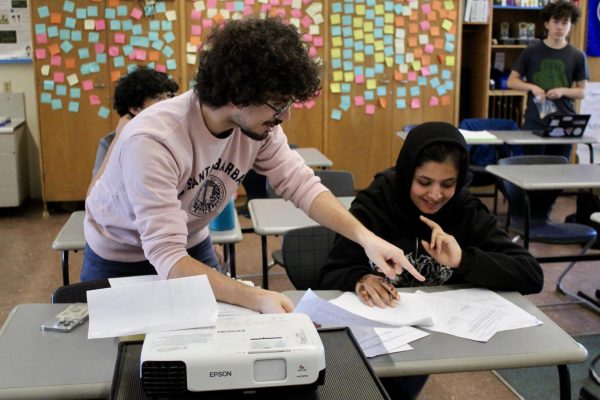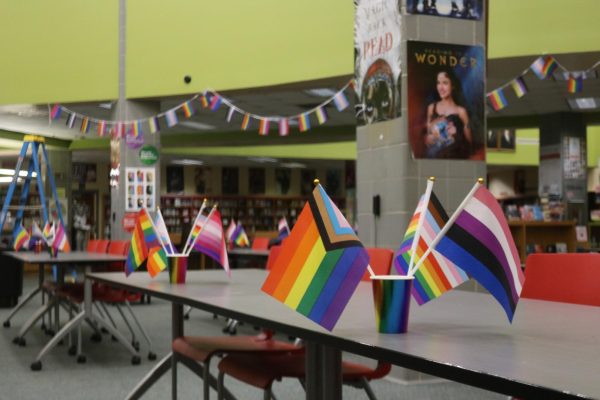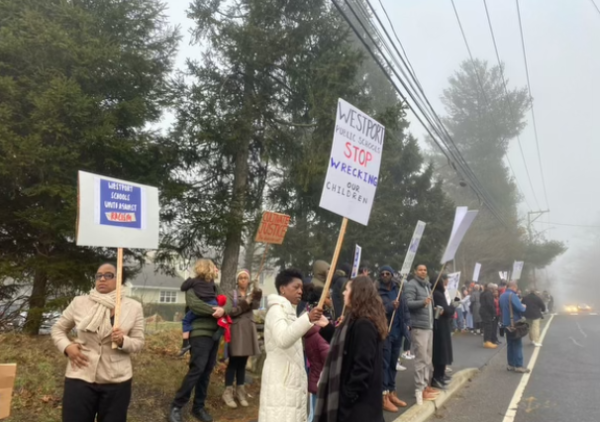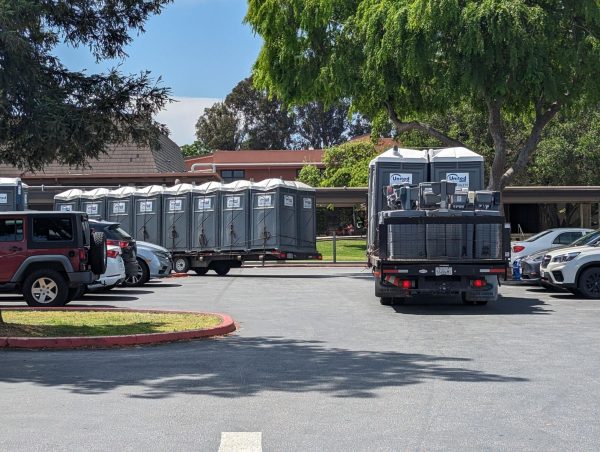Equity Above All
Superintendent Ron Williams Serves on California’s Community Vaccine Advisory Committee
Provided by Mrs. Petruschin
University Preparatory staff members with Superintendent Ron Williams at the November 8, 2016 Blue Ribbons Ceremony in Washington D.C. In 2016, University Preparatory School was nominated in the Exemplary High Performing Schools category. From left to right, those photographed are Mrs. Paula Petruschin, Mrs. Noemi Quevedo-Darling, Mrs. Jennifer Sooter, Principal Valarie Hatcher, and Dr. Ron Williams.
December 22, 2020
The FDA’s emergency authorization given on December 11, 2020, for Pfizer-BioNTech vaccines to be distributed throughout the United States has led to the creation of the California Community Vaccine Advisory Committee. Victor Valley Union High School District’s Superintendent Ron Williams joins many others in the medical and educational fields as part of this committee, offering his knowledge and opinion on how to best disperse the COVID-19 vaccines and ultimately get students and teachers back in classrooms.
Dr. Williams represents not only VVUHSD, but also San Bernardino County on the committee. No stranger to committees of national significance, Dr. Williams revealed, “I have worked on different initiatives for the state of California. I worked at the San Bernardino Superintendent of Schools. Bringing my national, state, and countywide perspective to VVUHSD has been my pleasure.”
Regarding his induction into the California Community Vaccine Advisory Committee, Superintendent Williams stated, “I was not expecting this. During Thanksgiving Break, I was called to be a representative for Governor Gavin Newsom’s office Committee for Vaccination [and] after a couple of weeks, the meetings started.”
California’s Community Vaccine Advisory Committee is headed by Acting State Health Officer Erica Pan and California Surgeon General Nadine Burke Harris. The committee attends meetings that are held every Wednesday and live streamed on YouTube for the public to watch. The main purpose of these public meetings is to help plan vaccine distribution among the diverse group of committee members and to make sure that the dispersion process is fair.
Detailing what committee meetings are like, Dr. Williams stated, “We meet three hours every week. There are approximately 70 of us on the committee and three or four of us are in the education community. Everything is moving quickly in the committee. A majority of the members are from the medical community, community organizations, and or medical organizations.”
Dr. Williams advocates for educators in the committee, “We are first focusing on supplying vaccines to those in the medical profession. Educators are a part of phase two. We’ve got to make sure that educators are in a safe environment.”
As for when we will be able to return to school, Dr. Williams focuses on how essential following social distancing guidelines are in stopping the spread. “Victorville is in the purple tier. Victorville has to move down a tier in order to consider reopening schools. We may be able to reopen during late spring. We have to change the conjecture due to our positive rate of cases in the community and county. It will be a challenge to reopen schools. We are depending on the community to follow social [distancing] rules to be able to get the positivity rate down, not only in Victorville, but all of San Bernardino county. I was on a conference call about Senate Assembly Bill 10, which states that schools should open up as soon as they can.” However, Williams acknowledges, “Educators can only regulate what is going on during school hours. One time, I saw students in the park without face masks and not following social [distancing] guidelines. We need to work together to change the conjecture rate in our county and in our district.”
All counties in California are on this tiered list based on the number of positive coronavirus cases. Tier One, or the purple tier, means that a county has a high number of coronavirus cases. There are more than seven cases per day and there are more than 8% positive coronavirus cases. Most indoor businesses are closed. Tier Two, the red tier, means that there are between four and seven coronavirus cases per day and 5% to 8% of coronavirus tests are positive. Some indoor businesses are closed. Tier Three, the orange tier, means that there are one to 3.9 cases everyday and 2.4% to 5.2% of coronavirus tests are positive. Not many indoor businesses are open, but there are some qualifications. Lastly, Tier Four, the yellow tier, means that there is less than one case per day and less than 2.2% or 2.0% of tests are positive. A lot of indoor businesses are open, but with some regulations. San Bernardino County and VVUHSD are in Tier One.
According to Williams, “California is not working alone in this.” Other states including Colorado, Nevada, Washington and Oregon in the Western States Pact are helping to issue the guidelines that will apply to how the coronavirus vaccine is distributed. During his time on the advisory board, Williams stated, “I have talked to numerous [individuals], including state, venue and…community advisory boards that are involved in putting [together] guidelines for California.”
On a national level, the FDA reviewed the scientific information available about the vaccines and believes that it is effective in stopping the coronavirus. Pfizer-BioNTech vaccines are 95% effective and had diverse test trial volunteers, who were 16 years old and older. The Moderna vaccine was also approved for distribution and is 94% effective. Both vaccines require the user to take two doses to make sure that they are fully protected from the coronavirus.
The one thing that surprised Dr. Williams was the rapidity of the vaccine distribution. “When I first became a part of this committee, I thought that it would be May or June when the general population would be able to get vaccinated. However, different providers of the vaccines are being put in emergency capacity. This process is moving much faster than two weeks ago when we first started.”
Dr. Williams detailed the vaccine dispersion as, “K-12 teachers, school staff, child care providers, people in homeless shelters, people with mental or physical disabilities, prisoners, older adults that aren’t a part of phase 1, foster youth, and the homeless are all a part of phase 2. I believe we will be able to move into phase 2 in early January, if we have enough vaccines mass produced and available.”
Concerning marginalized communities and coronavirus vaccine distribution, Dr. Williams states, “The main premise in the distribution of the vaccine is equity. It comes down to making sure that marginalized communities are given the vaccine. There are 3 to 4 phases in vaccine distribution. The first phase consists of the elderly and medical workers. The second phase covers educators. The third phase contains the homeless that are in homeless shelters and foster youth. Lastly, phase four covers the general population. The vaccine will not only be distributed to hospitals, but also to CVS and Walgreens.”
Given the large population of unsheltered homeless individuals without transportation in the High Desert, vaccine distribution will have to be easily accessible. Dr. Williams described how homeless people that aren’t in homeless shelters will be able to have access to the vaccine: “We are scheduled to receive a batch of 2 million coronavirus vaccines. These vaccines will be given to CVS pharmacies, Walgreens, and be much more widely distributed. These individuals may not have transportation. Local clinics can be the most accessible for local communities. Members can participate and take the vaccine that is available for them.”
In California, 6.5% of the population is Black, 71.9% is White, 1.6% is Native American or Alaskan Native, 15.5% is Asian. Native Hawaiian or Pacific Islander is 0.5%, 4.0% is Multiracial, 39.4% is Hispanic or Latino, and Non Hispanic Whites are 36.5% of the population. However, in the high desert, the racial makeup contains far more marginalized ethnic communities. In Victorville, minority populations are much larger, with a Hispanic population close to 60% and the Black population at 10%, which is nearly double that in California at large.
With such diversity comes other considerations, like will people be willing to get vaccinated? Despite Black Americans being hit the hardest from the coronavirus, the Washington Post reveals that many Black Americans are less willing than other racial or ethnic groups to take the COVID-19 vaccine. This unwillingness has to do with the mistrust that Black Americans have with the medical profession, due to medical racism.
During the 1930s, Tuskegee Institute in Alabama and the United Health Public Service worked together to track down Black men who had syphilis. Breaking every rule of ethics, these doctors let the disease go untreated to study its effects, causing the current mistrust of the medical profession among the Black community. Similarly, Henrietta Lacks died of cervical cancer while she was under the care of doctors at John Hopkins University. Her tumor cells were harvested without permission and her family was unaware that these cells were being used for research. Despite the financial gains doctors received for their research from these cells, the family received no compensation.
Unethical practices such as these have resulted in the distrust of the medical community that the vaccine distribution now faces. To combat this, cultural advertising has been a focal point for the coronavirus vaccine playbook. Trying to make sure that advertisers are able to convince everyone to get the coronavirus vaccine, they need to make sure that the information that is in public health messages or products is palatable for diverse audiences. It is emphasized that the language in the messages are clear and understandable and that they bring culture into consideration when presenting the information. For instance, advertisers need to make sure that the websites about the coronavirus vaccine are in the audience’s language and that any images they present aren’t culturally offensive.
Focusing on Hispanic/Latino, African American and Native Hawaiian/Pacific Islander populations, the San Bernardino County COVID-19 Equity Plan from October of this year outlines some of the measures the county must take to ensure impacted populations such as the ones above are equitably served. Being a representative on an advisory committee that is focused on ensuring safe and equitable treatment for all of California’s citizenry is an honor for Dr. Williams. He states, “It is a pleasure for me to represent educators and VVUHSD. It is a privilege and I am taking it very seriously. I not only represent the High Desert, VVUHSD, and San Bernardino County, I get to represent all administrators in California, the 6.2 million students in California, and the thousands of California districts. It is a privilege and an honor to represent them, as well.
Questions from members of the public may be sent to [email protected] to be answered by members of the committee. The next meeting will be held from 2PM-4PM on December 23, 2020, via a YouTube livestream.
This story was originally published on Listen UP on December 22, 2020.































![IN THE SPOTLIGHT: Junior Zalie Mann performs “I Love to Cry at Weddings,” an ensemble piece from the fall musical Sweet Charity, to prospective students during the Fine Arts Showcase on Wednesday, Nov. 8. The showcase is a compilation of performances and demonstrations from each fine arts strand offered at McCallum. This show is put on so that prospective students can see if they are interested in joining an academy or major.
Sweet Charity originally ran the weekends of Sept. 28 and Oct. 8, but made a comeback for the Fine Arts Showcase.
“[Being at the front in the spotlight] is my favorite part of the whole dance, so I was super happy to be on stage performing and smiling at the audience,” Mann said.
Mann performed in both the musical theatre performance and dance excerpt “Ethereal,” a contemporary piece choreographed by the new dance director Terrance Carson, in the showcase. With also being a dance ambassador, Mann got to talk about what MAC dance is, her experience and answer any questions the aspiring arts majors and their parents may have.
Caption by Maya Tackett.](https://bestofsno.com/wp-content/uploads/2024/02/53321803427_47cd17fe70_o-1-1200x800.jpg)
![SPREADING THE JOY: Sophomore Chim Becker poses with sophomores Cozbi Sims and Lou Davidson while manning a table at the Hispanic Heritage treat day during lunch of Sept 28. Becker is a part of the students of color alliance, who put together the activity to raise money for their club.
“It [the stand] was really fun because McCallum has a lot of latino kids,” Becker said. “And I think it was nice that I could share the stuff that I usually just have at home with people who have never tried it before.”
Becker recognizes the importance of celebrating Hispanic heritage at Mac.
“I think its important to celebrate,” Becker said. “Because our culture is awesome and super cool, and everybody should be able to learn about other cultures of the world.”
Caption by JoJo Barnard.](https://bestofsno.com/wp-content/uploads/2024/01/53221601352_4127a81c41_o-1200x675.jpg)













